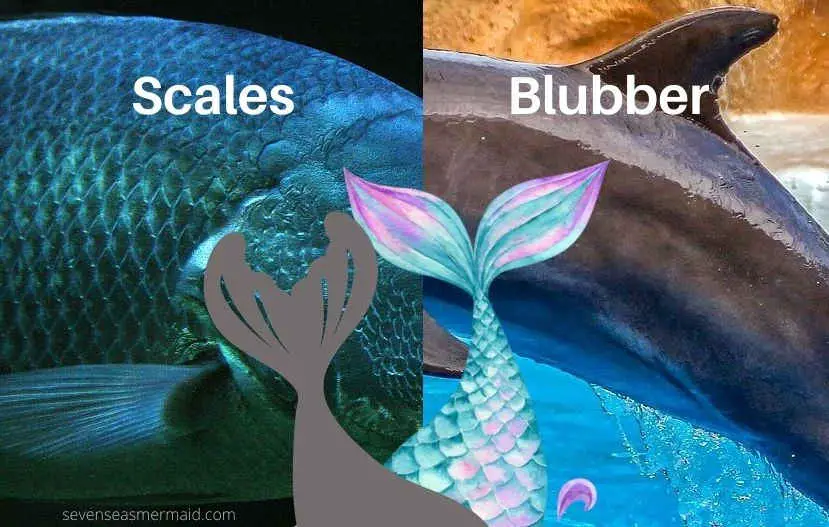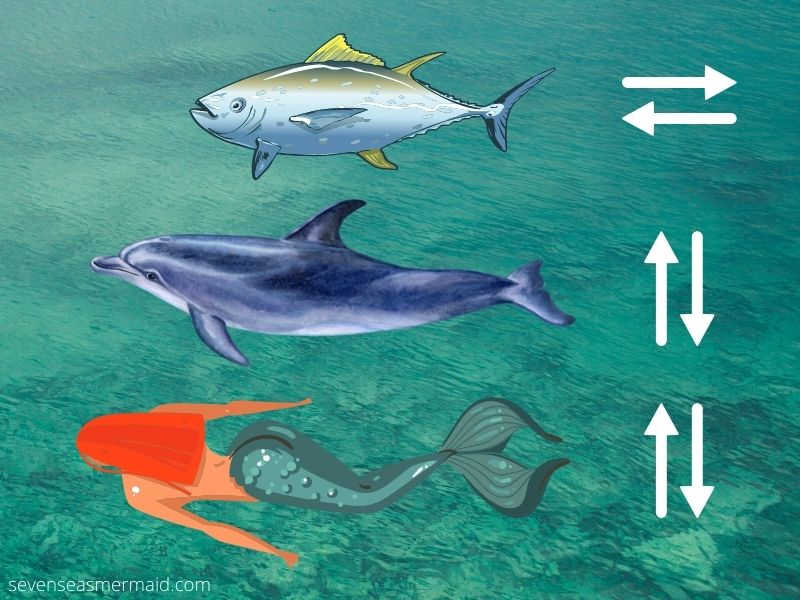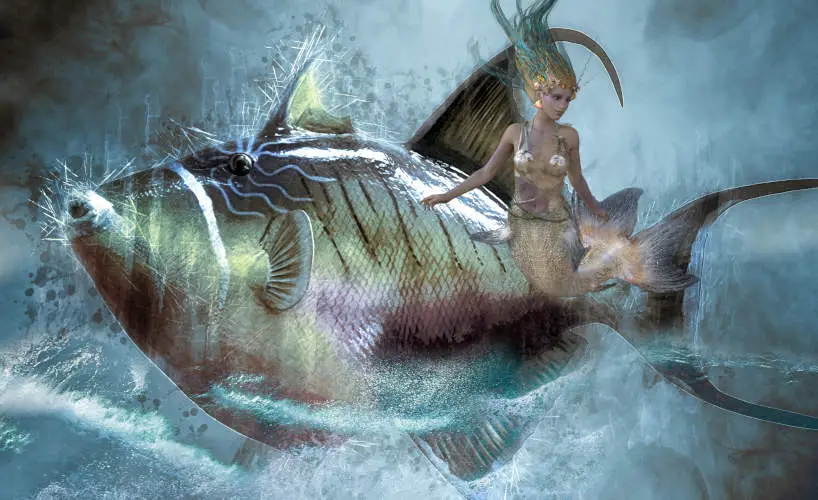Mermaids are commonly depicted with a human upper body and a fishtail. But does that make them fish? Or are they more of a mammal? I did some research into the biology of marine life to find out what mermaids most likely are. In this post, you will learn if mermaids are really fish.
A mermaid is part fish if you trust their description in many myths and stories. But when comparing mermaids to other fish and marine mammals, it becomes evident that they have much more biological traits in common with other marine mammals than with fish.
Let’s look at what these traits are and what they mean.
Are mermaids part fish or part mammal?
Mermaids are hybrid creatures, meaning they are half-human and half-animal. This means they are definitely not fully fish but, if at all, would be half fish because of their fish-tails.
But there are a few doubts about how much of a fish mermaids really are. As I explained in my post about whether mermaids could be real, it is unlikely that a creature could have both human and fish body parts aside from the realm of mythological creatures.
But even when presuming that mermaids are just mythological, some facts about them still indicate that they are less fish than you might think.
So let’s have a closer look at what animal mermaids might be more similar to – fish or mammals.
If mermaids were more similar to fish they would have more in common with bigger fish like for example tuna or sharks. But if they were more similar to mammals they would have more in common with marine mammals like dolphins and manatees.
There are several features that differentiate fish and mammals that live in the ocean.
In the following table, you can see a comparison between these traits and features between fish and marine mammals and which one of these animals mermaids are more similar to.
The traits of the fish and sea mammals are color-coded in the table. As you can see, the column of the mermaids has more of the same color as the column of the sea mammals. This means the mermaids have more in common with sea mammals than with fish!
| Traits | Fish | Marine Mammals | Mermaids |
| body coverage | scales | fur, hair, blubber | scales, (blubber) |
| tail movement | sideways | up and down | up and down |
| warm or cold-blooded | cold-blooded | warm-blooded | probably warm-blooded |
| breathing | gills | lungs | probably lungs |
| birth | eggs (except some sharks) | live-bearing | probably live-bearing |
| breastfeeding | no | yes | probably yes |
Of course, we cannot know for sure how mermaids really are since they are mythical creatures and no one knows if they really exist. But we can look at them from a biological perspective and find out that way how much of a fish they would really be if they were real.
Let me explain why exactly I think that mermaids have more of the traits of sea mammals and less in common with fish.
Traits that indicate that mermaids are fish
Why do people even think that mermaids are half fish? Mermaids have in fact been described as part fish for several thousand years. The main argument for their fishiness seems to have always been the scales on their tails.
Mermaids have scales
This description that mermaids are half fish goes all the way back to the first mermaid myth – the story of Atargatis who turned into half a fish. Later, fish-tailed mermen and mermaids became popular in Greek mythology (Triton and his children). In ancient Greek art, they were also always depicted with scales on their tails.
This way of thinking about mermaids remained the same even until many centuries later. In the 19th century Hans Christian Andersen wrote in his famous fairytale The Little Mermaid:
“…she had no feet, and her body ended in a fish’s tail.”
Hans Christian Andersen – The Little Mermaid
Thus, if you go after these myths and stories, then yes, a mermaid is half a fish.
But what does biology tell us about what kind of animal mermaids would really be?
How do we know that they really have scales? As I will explain in the following, all other traits of mermaids seem much more closely related to marine mammals than fish. Just the description of them having scales does not seem to make sense biologically speaking.
Fish (except some species like catfish) have scales on their bodies to protect them from infections and predators. These scales are generally hard and made from similar materials to our teeth and nails. They can have different colors, especially in the beautiful tropic fish and even give the impression of being glistening and glowing just like you would imagine a beautiful mermaid’s tail.
Marine mammals on the other hand do not have scales but instead skin similar to us. But under their skin is a thick layer of fat called blubber. This fat helps them stay warm as they need to keep up their body temperature.

But who knows, it is known that marine animals might have strongly influenced the mermaid myths. One of these animals are manatees, which are also called sirens. They can actually give the impression of having a scaly tail too, even though they do not have any scales whatsoever.
This is because green algae and barnacles can grow on their backs in an uneven pattern that can sometimes also look somewhat like scales.
So, while mythologically speaking mermaids definitely have fish scales, biologically it might just look like they do while they actually have a mammalian tail.
Traits that indicate that mermaids are marine mammals
Except for the scales, however, all the other listed traits mermaids seem to share with marine mammals.
Mermaids move their tails up and down
One of the most notable points in which mermaids differ from fish is how they move through the water.
Fish have back fins that are vertical. Therefore they have to move their tails to the left and right to move through the water. But marine mammals like dolphins and manatees have flukes that are horizontal. Thus, they have to move their tails up and down in order to propel themselves.
For mermaids, it is the same as for dolphins etc. Given their half-human anatomy, they have to move their tail up and down to effectively swim in the water.

This is actually how they do it in movies like Ariel The Little Mermaid and others as well.
Mermaids are probably warm-blooded
Fish are cold-blooded which means that their body temperature depends on their environment. If they swim in colder water their bodies are colder and if they swim in warmer waters, their bodies are warmer.
Marine mammals on the other hand need to constantly keep their body temperature stable like us. Since mermaids are half-human, their human upper body would definitely be warm-blooded.
Now, it is not possible that their lower body would work so differently that it would be cold-blooded like that of a fish. It would have to be separated from the blood flow of the upper body which is extremely unlikely.
Therefore, the lower part of the mermaids must be warm-blooded as well. Only like this, their bodies could work normally.
Mermaids probably breathe through lungs
Additionally, it is also likely that mermaids would breathe through lungs. After all, both fish and mammals breathe through organs on their upper body: gills or lungs. And since mermaids have the upper body of a human, they must also have lungs.
But don’t mermaids need gills? How do they stay underwater for long periods of time if they cannot breathe like fish?
Well, if they really live in underwater kingdoms on the ground of the ocean as in many myths and stories, then they might need gills. That is because marine mammals can only stay underwater for around 20 minutes at a time. After that, they have to come to the surface to breathe air.
But yes, from a biological perspective, mermaids would probably do it like dolphins and manatees. They would spend a lot of time in more shallow water where they can breathe air easily. And when going hunting they would dive deeper for short amounts of time.
Mermaids are probably live-bearing
The same goes for the way, mermaids would bear their babies. Fish usually lay eggs (except some sharks and rays). But marine mammals are live-bearing just like us, meaning their babies are born relatively ready for the world.
It would be very unlikely that mermaids lay eggs for several reasons. I explained this in my article about how mermaids have babies.
Therefore, in this regard, they are more similar to marine mammals as well.
Mermaids probably breastfeed
This point goes in line with the last one. Fish do not have breasts and do not breastfeed their babies. They mostly just lay their eggs and then leave their offspring alone. But marine mammals do nurse their calves.
Now, dolphins etc. do not have breasts on the outside of their bodies like humans. But they do produce milk as well and their calves drink from the “mammary slit” on the belly of the mother.
If you think about it, why would mermaids have breasts if they do not use them? It would be very likely that their human upper body works just like ours and they would breastfeed their babies just like us.
Thus in total, mermaids seem to have much more in common with mammals than with fish. That is of course also due to the fact that they are half mammal, to begin with – humans are mammals too after all. Therefore, it is not surprising that they are not that similar to fish in general even though it is always assumed that they are half fish.
Are mermaids animals or humans?
No matter if their tail is fishier or more mammalian, the lower part of the mermaids would still be an animal part right? Not necessarily!
Maybe we should not think about mermaids as half-animal and half-human. Yes, they have a similar lower body as other animals. But they are actually humanoid creatures.
This means they are much more similar to humans in the way they behave and look than to any other animals. If we can believe the myths and stories, they have the same kind of consciousness and intelligence as humans.
Because of this, it would be more correct to think of them as humanoid merpeople – human-like beings that live in the ocean and not merely animals.
You can learn more about what mermaids might look like and that they might be our long-lost humanoid cousins, if they were real, in my article about whether mermaids could exist.

